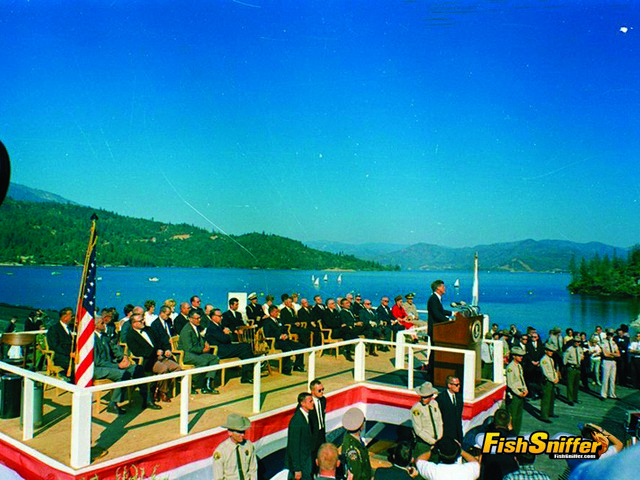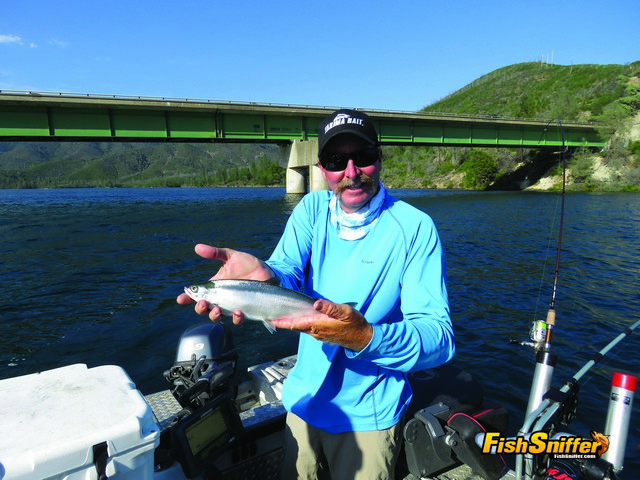“Every time we make a determination to set aside a seashore for the use of future generations, every time we build these great projects, we develop the water resources, we set aside recreational areas, we can be sure they are going to be used. Three hundred and fifty million Americans will live in this country of ours in the short space of less than 40 years, where now there are 180 million. What will they do? What kind of a country will they find? How much recreation will be possible for them? I think if we make the right decisions now they will be as grateful to us as we were and are to Gifford Pinchot and Theodore Roosevelt for the things they did 45 and 50 years ago.”

“We witness today the completion of a project which symbolizes the goals to which we are committed. The Whiskeytown Reservoir is not the largest structure on the Trinity River, but its completion is significant because this is the last of the Trinity project dams.”
“With the Trinity division completed and the upper reaches of the Sacramento now harnessed, Shasta County and its neighbors are assured of water and power. They can enjoy new chances for recreational use, and new access to open space.”- President John F. Kennedy, September 28, 1963.
Those were the words of our 35th President at the dedication of Whiskeytown Reservoir, a mere 7 weeks and 6 days before he was cut down by a sniper’s or snipers’ bullets in Dallas, Texas on November 22, 1963.
When I visited Whiskeytown on the afternoon of July 7 and heard a recording of these remarks at the Kennedy Memorial on the corner of Whiskeytown Dam they seemed at once poignant and tragic, because through the lense of history we know that the optimistic and foresighted words that Kennedy spoke were being uttered by a condemned man whose life was soon to come to a tragic and premature end.
When I returned to my truck that evening after spending the afternoon fishing Whiskeytown’s waters, enjoying one of the recreational opportunies the lake offers just as the President predicted I would, his words and my visit to Whiskeytown’s Kennedy Memorial took on even more significance.
Fore when I turned over the ignition and the radio came on I learned that a sniper, as it turned out, a delusional man with a heart filled with hatred and anger had shot a dozen police offers killing five of them in Dallas. The shootings took place a few blocks from the spot where the President was shot 53 years before.
I was stunned when I heard about the police shooting and I continue to be stunned today. I guess what I find most unsettling is that in a country where every possible resource is at our finger tips, such as clean water, markets full of food and access to free public education as well as the availability of wide spread aid and services to the poor, that someone would have the anger and audacity to lash out at the police.
After all police with very few exceptions are the members of our society that work so hard to ensure and preserve peace, justice for all and a safe environment ripe with opportunity.
Right now when I read the news, I feel as if the world is cracked. Offering solutions is far beyond my pay grade. All I can do is hope that the crack heals and that the tensions that now exist ramp down to a safer and saner level.
So how was the fishing at Whiskeytown? Pretty darn good!

Fish Sniffer staffer Gene Rush and I had been itching to go kokanee fishing for quite a while. With the sockeye bite raging at Whiskeytown, I contacted Kirk Portocarrero of SacRiverGuide.Com and set up a trip.
“The kokanee bite is wide open at Whiskeytown. I do have a trout trip on the Sacramento on the morning of July 7, but I’m free to fish Whiskeytown from mid-afternoon until dark,” he related.
Awesome, we were in business and I was at once excited and intrigued. I’d never fished for kokanee in the afternoon before. Kokanee fishing is most often an early morning affair and typically the bite backs off during the middle of the day. I’d long suspected that the bite would come back on in the evening, but I’d never actually tried to catch them much after lunchtime.
The late start allowed Gene and I to take a leisurely drive north from our homes in the Gold Country foothills and we arrived at the lake about 1 o’clock. While waiting for Kirk to arrive we toured the visitor center, checked out the Kennedy Memorial and shot video from various locations around the lake.
Kirk arrived at the launch ramp at about 2:30 and Monte Currier, CDFW Environmental Scientist for the Reservoir Sportfish Project arrived about 3. Kirk had arranged for Monte to join us on the water and share some of his knowledge about Whiskeytown in general and the lake’s kokanee in particular.
With Kirk’s big Willie Boat launched, we started trolling a short distance from the launch ramp headed for the Highway 299 Bridge, one of Whiskeytown’s traditional kokanee hotspots.
The salmon were there, fat, feisty and full of fight. Gene landed a plump 14 incher about 3 minutes into the trip and we enjoyed pretty steady action for the rest of the afternoon and evening.
Yakima Bait dodgers, Yakima Spinners, hoochies and herring scented corn were a winning combination for us. At times when the bite slowed a bit, we’d play around with the color of the lures until we started hooking up again. At times they wanted orange, then pink and towards evening green lures were hot.
By 8 o’clock we had three limits of 15 salmon on ice and we’d probably hooked and lost an equal number, maybe more. The salmon were handsome chrome bright 1 pound cookie cutter fish ranging from 14 to 14.5 inches. One or two of them might have approached 15 inches.
As we fished Monte shared a plethora of facts. For starters, planting started at the lake as soon as the dam was completed in ’63, with the introduction of brown trout, largemouth and smallmouth bass and threadfin shad. In ’64 Kamloops rainbows were planted along with more shad.
In ’65 and ’66 kokanee planting got underway. The first year 412,000 fish from Kootenay Lake in Canada and Bucks Lake in California went into the lake. The next year 455,000 ‘kokes went into the system.
In subsequent years, the DFW introduced other species into the lake including brook trout, king salmon and spotted bass.
Monte provided me with a data sheet that outlined the number of kokanee planted at the lake year by year since 1965. The largest yearly plant was 455,428 in ’66. Throughout the ‘70s the number dropped down in the 150,000 to 175,000 range. Then in the late ‘90’s the number dropped to 50,000, then to 25,000 and since 2011 the lake hasn’t received any kokanee plants.
The lake’s tributary offers good spawning habitat and solid production. What is pretty stark in looking at the data is that when kokanee plants were at their highest, the average size of the fish measured during spawner surveys was the lowest.
In the wake of the robust planting schedule of the late ‘70s the average size of the fish had slumped to a tiny 10.2 inches. These days with fewer fish in the lake, we are seeing a resurgence in the average size of the salmon. The high thus far was in 2011 when the average fish went 15.6 inches. Since then there has been some fluctuation, but the average salmon size recorded hasn’t dropped below 12 inches and is typically in the 13 to 14 inch range.
For me and a lot of other anglers 13 inches is the tipping point in terms of kokanee. When the fish are 13 inches or better they fight like demons and provide great eating. On the other hand, fish in the 10 to 11 inch range are a snooze, simply because they don’t have the size to put up a good fight and don’t have the girth to provide substantial fillets.
As of now, it looks like the DFW has the kokanee numbers dialed in at Whiskeytown and the reservoir is alive with good size sockeyes.
If you’d like to get out on Whiskeytown and round up a limit of kokanee, give Captain Kirk Portocarrero of SacRiverGuide.Com a call at (800) 670-4448.
“I’m planning on hitting the Sacramento River hard during the first week of the salmon season, which starts on July 16. From there I’m going to let the action tell me where I spend my time fishing. If there are decent numbers of kings in the river, I’ll be out there looking for big salmon, but if kings are a no show in the river early in the season I’ll be right back out here at Whiskeytown chasing kokanee. I love the Redding area. We’ve got lots of options up here with wild rainbows and kings in the river and a full menu of gamefish at reservoirs like Whiskeytown and Shasta,” Kirk quipped.
